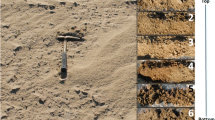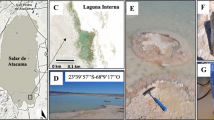Abstract
The Central Andes in northern Chile contains a large number of closed basins whose central depression is occupied by saline lakes and salt crusts (salars). One of these basins is Salar de Llamara (850 m a.s.l.), where large domed structures of seemingly evaporitic origin forming domes can be found. In this work, we performed a detailed microbial characterization of these domes. Mineralogical studies revealed gypsum (CaSO4) as a major component. Microbial communities associated to these structures were analysed by 454 16S rDNA amplicon sequencing and compared between winter and summer seasons. Bacteroidetes Proteobacteria and Planctomycetes remained as the main phylogenetic groups, an increased diversity was found in winter. Comparison of the upper air-exposed part and the lower water-submerged part of the domes in both seasons showed little variation in the upper zone, showing a predominance of Chromatiales (Gammaproteobacteria), Rhodospirillales (Alphaproteobacteria), and Sphingobacteriales (Bacteroidetes). However, the submerged part showed marked differences between seasons, being dominated by Proteobacteria (Alpha and Gamma) and Verrucomicrobia in summer, but with more diverse phyla found in winter. Even though not abundant by sequence, Cyanobacteria were visually identified by scanning electron microscopy (SEM), which also revealed the presence of diatoms. Photosynthetic pigments were detected by high-performance liquid chromatography, being more diverse on the upper photosynthetic layer. Finally, the system was compared with other endoevaporite, mats microbialite and Stromatolites microbial ecosystems, showing higher similitude with evaporitic ecosystems from Atacama and Guerrero Negro. This environment is of special interest for extremophile studies because microbial life develops associated to minerals in the driest desert all over the world. Nevertheless, it is endangered by mining activity associated to copper and lithium extraction; thus, its environmental protection preservation is strongly encouraged.






Similar content being viewed by others
References
Risacher F, Alonso H, Salazar C (2003) The origin of brines and salts in Chilean salars: a hydrochemical review. Earth-Sci Rev 63(3):249–293
Barbieri R, Stivaletta N (2011) Continental evaporites and the search for evidence of life on Mars. Geol J 46(6):513–524
Clauzon G, Suc J-P, Gautier F, Berger A, Loutre M-F (1996) Alternate interpretation of the Messinian salinity crisis: controversy resolved? Geology 24(4):363–366
McKay CP, Imre Friedman E, Wharton RA, Davies WL (1992) History of water on Mars: a biological perspective. Adv Space Res 12(4):231–238
Wierzchos J, Cámara B, De Los RA, Davila A, Sánchez Almazo I, Artieda O, Wierzchos K, Gómez Silva B, McKay C, Ascaso C (2011) Microbial colonization of Ca-sulfate crusts in the hyperarid core of the Atacama Desert: implications for the search for life on Mars. Geobiology 9(1):44–60
Stoertz GE, Ericksen GE (1974) Geology of salars in northern Chile. Prof Pap US Geol Surv 811:65 pp
Chong G (1984) Die Salare in Nordchile: Geologie, Struktur und Geochemie. Schweizerbart'sche Verlagsbuchhandlung
Demergasso C, Chong G, Galleguillos P, Escudero L, Martínez-Alonso M, Esteve I (2003) Microbial mats from the Llamará salt flat, northern Chile. Rev Chil Hist Nat 76(3):485–499
Farias ME, Rascovan N, Toneatti DM, Albarracin VH, Flores MR, Poire DG, Collavino MM, Aguilar OM, Vazquez MP, Polerecky L (2013) The discovery of stromatolites developing at 3570 m above sea level in a high-altitude volcanic lake Socompa, Argentinean Andes. PLoS One 8(1):e53497. doi:10.1371/journal.pone.0053497
Stivaletta N, Barbieri R, Cevenini F, Lopez-Garcia P (2011) Physicochemical conditions and microbial diversity associated with the evaporite deposits in the Laguna de la Piedra (Salar de Atacama, Chile). Geomicrobiol J 28(1):83–95
Farias ME, Contreras M, Rasuk MC, Kurth D, Flores MR, Poire DG, Novoa F, Visscher PT (2014) Characterization of bacterial diversity associated with microbial mats, gypsum evaporites and carbonate microbialites in thalassic wetlands: Tebenquiche and La Brava, Salar de Atacama, Chile. Extremophiles 18(2):311–329. doi:10.1007/s00792-013-0617-6
Pueyo JJ, Chong G, Jensen A (2001) Neogene evaporites in desert volcanic environments: Atacama Desert, northern Chile. Sedimentology 48(6):1411–1431
Sahl JW, Pace NR, Spear JR (2008) Comparative molecular analysis of endoevaporitic microbial communities. Appl Environ Microbiol 74(20):6444–6446
Sørensen KB, Canfield DE, Teske AP, Oren A (2005) Community composition of a hypersaline endoevaporitic microbial mat. Appl Environ Microbiol 71(11):7352–7365
Spear JR, Ley RE, Berger AB, Pace NR (2003) Complexity in natural microbial ecosystems: the Guerrero Negro experience. Biol Bull 204(2):168–173
López PL, Auqué LF, Garcés I, Chong G (1999) Características geoquímicas y pautas de evolución de las salmueras superficiales del Salar de Llamará, Chile. Rev Geol Chile 26(1):89–108
Eaton AD, Clesceri LS, Rice EW, Greenberg AE, Franson MAH (2005) Standard methods for the examination of water and wastewater. Centennial edition. Published jointly by American Public Health Association, American Water Works Association, and Water Environment Federation, Washington, DC
Borrego C, Garcia-Gil L (1994) Separation of bacteriochlorophyll homologues from green photosynthetic sulfur bacteria by reversed-phase HPLC. Photosynth Res 41(1):157–164
López‐López A, Yarza P, Richter M, Suárez‐Suárez A, Antón J, Niemann H, Rosselló‐Móra R (2010) Extremely halophilic microbial communities in anaerobic sediments from a solar saltern. Environ Microbiol Rep 2(2):258–271
Caporaso JG, Kuczynski J, Stombaugh J, Bittinger K, Bushman FD, Costello EK, Fierer N, Pena AG, Goodrich JK, Gordon JI, Huttley GA, Kelley ST, Knights D, Koenig JE, Ley RE, Lozupone CA, McDonald D, Muegge BD, Pirrung M, Reeder J, Sevinsky JR, Turnbaugh PJ, Walters WA, Widmann J, Yatsunenko T, Zaneveld J, Knight R (2010) QIIME allows analysis of high-throughput community sequencing data. Nat Methods 7(5):335–336. doi:10.1038/nmeth.f.303
Hounslow AW (1995) Water quality data: analysis and interpretation. CRC, Boca Raton
Oren A, Kuhl M, Karsten U (1995) An endoevaporitic microbial mat within a gypsum crust: zonation of phototrophs, photopigments, and light penetration. Mar Ecol Prog Ser 128:151–159
Stivaletta N, Lopez-Garcia P, Boihem L, Millie DF, Barbieri R (2010) Biomarkers of endolithic communities within gypsum crusts (southern Tunisia). Geomicrobiol J 27(1):101–110
Demergasso C, Casamayor EO, Chong G, Galleguillos P, Escudero L, C P‐A (2004) Distribution of prokaryotic genetic diversity in athalassohaline lakes of the Atacama Desert, Northern Chile. FEMS Microbiol Ecol 48(1):57–69
Allen MA, Goh F, Burns BP, Neilan BA (2009) Bacterial, archaeal and eukaryotic diversity of smooth and pustular microbial mat communities in the hypersaline lagoon of Shark Bay. Geobiology 7(1):82–96
Baumgartner LK, Spear JR, Buckley DH, Pace NR, Reid RP, Dupraz C, Visscher PT (2009) Microbial diversity in modern marine stromatolites, Highborne Cay, Bahamas. Environ Microbiol 11(10):2710–2719. doi:10.1111/j.1462-2920.2009.01998.x
Ley RE, Harris JK, Wilcox J, Spear JR, Miller SR, Bebout BM, Maresca JA, Bryant DA, Sogin ML, Pace NR (2006) Unexpected diversity and complexity of the Guerrero Negro hypersaline microbial mat. Appl Environ Microbiol 72(5):3685–3695. doi:10.1128/AEM.72.5.3685-3695.2006
Caumette P (1993) Ecology and physiology of phototrophic bacteria and sulfate-reducing bacteria in marine salterns. Experientia 49(6–7):473–481
Caumette P, Matheron R, Raymond N, Relexans J-C (1994) Microbial mats in the hypersaline ponds of Mediterranean salterns (Salins-de-Giraud, France). FEMS Microbiol Ecol 13(4):273–286
Margheri M, Tredici M, Barsanti L, Balloni W (1987) The photosynthetic community of the Trapani saline lagoons: an alternative option for the exploitation of an extreme environment. Ann Microbiol 37:203–215
Ali-Bik MW, Metwally HI, Kamel MG, Wali AM (2011) Gypsum and dolomite biomineralization in endoevaporitic microbial niche, EMISAL, Fayium, Egypt. Environ Earth Sci 62(1):151–159
Taher A, Wahab SA, Philip G, Krumbein W, Wali A (1995) Evaporitic sedimentation and microbial mats in a salina system (Port Fouad, Egypt). Int J Salt Lake Res 4(2):95–116
Oren A, Sørensen KB, Canfield DE, Teske AP, Ionescu D, Lipski A, Altendorf K (2009) Microbial communities and processes within a hypersaline gypsum crust in a saltern evaporation pond (Eilat, Israel). Hydrobiologia 626(1):15–26
Airs RL, Keely BJ (2003) A high resolution study of the chlorophyll and bacteriochlorophyll pigment distributions in a calcite/gypsum microbial mat. Org Geochem 34(4):539–551
Rothschild LJ, Giver LJ, White MR, Mancinelli RL (1994) Metabolic activity of microorganisms in evaporites. J Phycol 30(3):431–438
Beveridge T, Fyfe W (1985) Metal fixation by bacterial cell walls. Can J Earth Sci 22(12):1893–1898
Beveridge TJ (1981) Ultrastructure, chemistry, and function of the bacterial wall. Int Rev Cytol 72:229–317
Cody A, Cody R (1989) Evidence for micro-biological induction of montmartre twinning of gypsum (CaSO4.2H2O). J Cryst Growth 98(4):721–730
Douglas S (2005) Mineralogical footprints of microbial life. Am J Sci 305(6–8):503–525
Ludwig R (2004) Carbon cycling and calcification in hypersaline microbial mats. PhD Thesis, Bremen University
Van Lith Y, Warthmann R, Vasconcelos C, McKenzie JA (2003) Microbial fossilization in carbonate sediments: a result of the bacterial surface involvement in dolomite precipitation. Sedimentology 50(2):237–245
Vasconcelos C, Warthmann R, McKenzie JA, Visscher PT, Bittermann AG, van Lith Y (2006) Lithifying microbial mats in Lagoa Vermelha, Brazil: modern Precambrian relics? Sediment Geol 185(3):175–183
Mobberley JM, Ortega MC, Foster JS (2012) Comparative microbial diversity analyses of modern marine thrombolitic mats by barcoded pyrosequencing. Environ Microbiol 14(1):82–100. doi:10.1111/j.1462-2920.2011.02509.x
Acknowledgements
This work was supported by Sociedad Química y Minera de Chile and Centro de Ecología Aplicada. Flores, Kurth and Rasuk are recipients of a CONICET fellowship. We also want to thank Lic Javier Maldonado of CONICET for his assistance in field trip and Lic. Cecilia Genazzini and Mr. Pablo García of CONICET for their assistance in the XRD laboratory.
Author information
Authors and Affiliations
Corresponding author
Rights and permissions
About this article
Cite this article
Rasuk, M.C., Kurth, D., Flores, M.R. et al. Microbial Characterization of Microbial Ecosystems Associated to Evaporites Domes of Gypsum in Salar de Llamara in Atacama Desert. Microb Ecol 68, 483–494 (2014). https://doi.org/10.1007/s00248-014-0431-4
Received:
Accepted:
Published:
Issue Date:
DOI: https://doi.org/10.1007/s00248-014-0431-4




